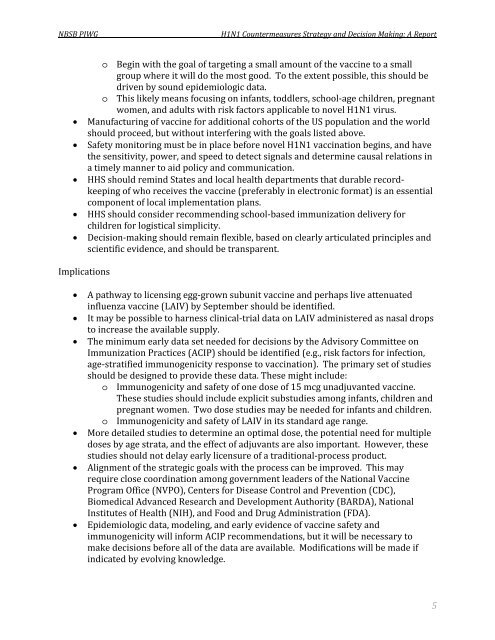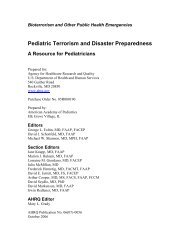H1N1 COUNTERMEASURES STRATEGY AND ... - PHE Home
H1N1 COUNTERMEASURES STRATEGY AND ... - PHE Home
H1N1 COUNTERMEASURES STRATEGY AND ... - PHE Home
You also want an ePaper? Increase the reach of your titles
YUMPU automatically turns print PDFs into web optimized ePapers that Google loves.
NBSB PIWG<br />
<strong>H1N1</strong> Countermeasures Strategy and Decision Making: A Report<br />
<br />
<br />
<br />
<br />
<br />
o Begin with the goal of targeting a small amount of the vaccine to a small<br />
group where it will do the most good. To the extent possible, this should be<br />
driven by sound epidemiologic data.<br />
o This likely means focusing on infants, toddlers, school‐age children, pregnant<br />
women, and adults with risk factors applicable to novel <strong>H1N1</strong> virus.<br />
Manufacturing of vaccine for additional cohorts of the US population and the world<br />
should proceed, but without interfering with the goals listed above.<br />
Safety monitoring must be in place before novel <strong>H1N1</strong> vaccination begins, and have<br />
the sensitivity, power, and speed to detect signals and determine causal relations in<br />
a timely manner to aid policy and communication.<br />
HHS should remind States and local health departments that durable recordkeeping<br />
of who receives the vaccine (preferably in electronic format) is an essential<br />
component of local implementation plans.<br />
HHS should consider recommending school‐based immunization delivery for<br />
children for logistical simplicity.<br />
Decision‐making should remain flexible, based on clearly articulated principles and<br />
scientific evidence, and should be transparent.<br />
Implications<br />
<br />
<br />
<br />
<br />
<br />
<br />
A pathway to licensing egg‐grown subunit vaccine and perhaps live attenuated<br />
influenza vaccine (LAIV) by September should be identified.<br />
It may be possible to harness clinical‐trial data on LAIV administered as nasal drops<br />
to increase the available supply.<br />
The minimum early data set needed for decisions by the Advisory Committee on<br />
Immunization Practices (ACIP) should be identified (e.g., risk factors for infection,<br />
age‐stratified immunogenicity response to vaccination). The primary set of studies<br />
should be designed to provide these data. These might include:<br />
o Immunogenicity and safety of one dose of 15 mcg unadjuvanted vaccine.<br />
These studies should include explicit substudies among infants, children and<br />
pregnant women. Two dose studies may be needed for infants and children.<br />
o Immunogenicity and safety of LAIV in its standard age range.<br />
More detailed studies to determine an optimal dose, the potential need for multiple<br />
doses by age strata, and the effect of adjuvants are also important. However, these<br />
studies should not delay early licensure of a traditional‐process product.<br />
Alignment of the strategic goals with the process can be improved. This may<br />
require close coordination among government leaders of the National Vaccine<br />
Program Office (NVPO), Centers for Disease Control and Prevention (CDC),<br />
Biomedical Advanced Research and Development Authority (BARDA), National<br />
Institutes of Health (NIH), and Food and Drug Administration (FDA).<br />
Epidemiologic data, modeling, and early evidence of vaccine safety and<br />
immunogenicity will inform ACIP recommendations, but it will be necessary to<br />
make decisions before all of the data are available. Modifications will be made if<br />
indicated by evolving knowledge.<br />
5
















